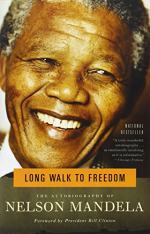|
This section contains 457 words (approx. 2 pages at 400 words per page) |

|
Long Walk to Freedom Summary & Study Guide Description
Long Walk to Freedom Summary & Study Guide includes comprehensive information and analysis to help you understand the book. This study guide contains the following sections:
This detailed literature summary also contains Topics for Discussion on Long Walk to Freedom by Nelson Mandela.
The following version of this book was used to create the guide: Mandela, Nelson Rolihlahla. Long Walk to Freedom. Little, Brown, and Company, 1994.
In his memoir, Long Walk to Freedom, South African freedom fighter and author Nelson Mandela describes his trajectory from a Xhosa boy in a small village in the Transkei, to a revolutionary anti-apartheid resistance fighter, to a political prisoner held for 27 years in prison, and finally to South Africa’s first black President. The memoir divided into nine parts.
In Part One: A Country Childhood, Mandela describes his birth in 1918 and his childhood in the Transkei of South Africa. The son of a local chief, Mandela recalls passing time playing childhood games and listening to his parents’ stories. He describes his attempts to gain an education, mostly at missionary schools. In Part Two: Johannesburg, Mandela describes his time as a young man in Johannesburg, where he pursues law studies. There, he learns more about urban life in South Africa, works in a law firm, and gains exposure to the ANC and Communist Party in South Africa.
In Part Three: Birth of a Freedom Fighter, Mandela begins spending time at the home of Walter Sisulu, a prominent member of the ANC. There, Mandela begins to get involved in the ANC. In Part Four: The Struggle is My Life, Mandela struggles to balance his increasing involvement in the ANC with his wife Evelyn and children, who want more attention from him. He faces his first travel ban and increasing scrutiny from the state.
In Part Five: Treason, Mandela and dozens of other ANC party members are arrested and charged with treason under the Suppression of Communism Act. They are eventually found to be not guilty. In Part Six: The Black Pimpernel, Mandela goes into hiding. During this time, he founds the militant organization MK and plans a number of acts of sabotage against the government. In Part Seven: Rivonia, Mandela and eight others are arrested and charged with incitement to strike and illegally leaving the country. He is charged with life imprisonment and spends the next 28 years in Robben Island--an experience that he details in Part Eight: Robben Island: The Dark Years and Part Nine: Robben Island: Beginning to Hope.
In Part Ten: Talking with the Enemy, Mandela is taken into solitary confinement in the eighties and decides that the time is right to initiate negotiations with the government, which is now headed by the more moderate (though still National Party) F.W. de Klerk. In Part Eleven: Freedom, de Klerk sets Mandela free and together they work towards the first free elections in 1994. The ANC wins with more than 60 percent of the votes and Mandela becomes president of the newly freed South Africa.
Read more from the Study Guide
|
This section contains 457 words (approx. 2 pages at 400 words per page) |

|



